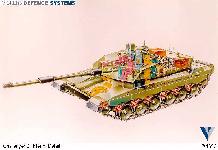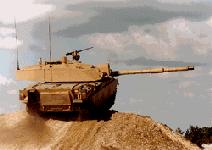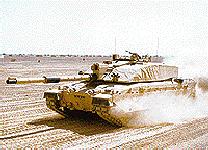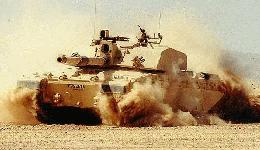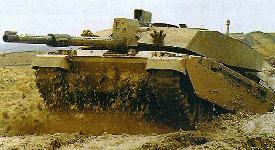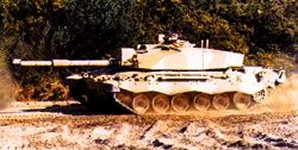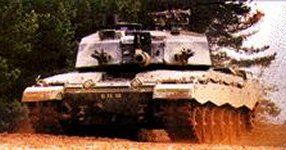Challenger 2 Main Battle Tank
The Challenger 2 is the first British Army tank since World War II to be designed, developed and produced exclusively by a single prime contractor, Vickers Defence Systems, with set reliability goals laid down in the fixed price contract. The hull and automotive parts of the Challenger 2 are based upon its predecessor Challenger 1, but Challenger 2 incorporates over 150 improvements aimed at increasing reliability and maintainability. The turret of Challenger 2 is a totally new design. Armour is an uprated version of Challenger 1's Chobham armour. The Challenger 2 is the best protected tank in NATO (10) incorporating Chobham second-generation armour plating. Its NBC (nuclear, biological and chemical protection) system is capable of dealing with all known threats and, for the first time in any British tank, the crew compartment has both a heating and a cooling system.The main armament consists of a Royal Ordnance 120 mm rifled tank gun designated the L30. It also incorporates a McDonnell Douglas Helicopter Systems 7.62 mm chain gun, which is already in service in the British Army, being installed in the GKN Defence Warrior mechanised combat vehicle, and a 7.62 mm anti-aircraft machine gun. The Challenger 2�s fire control system is the latest-generation digital computer from Computing Devices Company (CDC) of Canada and is an improved version of that installed in the US M1A1 Abrams tank. It also has growth capacity for future enhancement such as a Battlefield Information Control System and navigation aids. The Challenger 2 carries a crew of 4 and has a combat weight of 62.5 tonnes. It has a maximum road speed of 56 km/h and a range of 250 km cross country and 450 km on the road.
The Challenger 2 (CR2) project includes the development and production of 386 CR2 Main Battle Tanks (MBTs), 22 Driver Training Tanks (DTTs), CHARM 3 ammunition and a full support package including training equipment and initial spares.
Prime Contractor is Vickers Defence Systems plc. Vickers Defence systems started work on the Challenger 2 in November 1986 as a private venture and shortly afterwards, in March 1987, made its first presentation of the vehicle to the British Ministry of Defence. In February 1988, Vickers submitted a formal proposal regarding the tank to the MOD following the issue of the staff requirement. In December 1988 it was announced that Vickers Defence Systems was to be awarded a �90 million contract to undertake a demonstration phase (also referred to as the proof of principle phase) which lasted until September 1990.
In June 1991 the British Government selected the Challenger 2 and placed an order worth �520 million for 127 Challenger 2 MBTs and 13 driver training tanks. Production began in 1993 and the first vehicles were delivered in July 1994. The Challenger 2 is produced at the Vickers Defence Systems plants in Leeds and Newcastle.There are over 250 subcontractors (both UK and Overseas) involved at some point in the manufacturing process. Among the most significant are: Royal Ordnance (Main and Secondary armaments); Blair Catton (Track); and GEC-Marconi (Gun Control). The requirement to replace Challenger 1 (CR1) MBT led to the placement of a follow-on order with Vickers Defence Systems. In July 1994, Vickers Defence Systems received a further order from the UK MOD for the supply of 259 Challenger 2 and nine driver training tanks plus training and logistic support. The total value of the contract is �800 million and means that production of the Challenger 2 will continue at least until the year 2000 and that the British Army will be equipped with Challenger 2s while the Challenger 1 will be phased out. The CR2 In-Service Reliability Demonstration (ISRD) milestone was successfully achieved in January 1999. The ISRD took place from September to December 1998 and trialled 12 British Army crewed MBTs at the Bovington test tracks and Lulworth Bindon Ranges. The ISRD was a great success in that CR2 not only achieved the targets but exceeded them in all areas set by the Customer�s Staff Requirement.The Royal Scots Dragoon Guards in Germany, the first of six post-SDR Armoured Regiments, started to take delivery of CR2 in January 1998 and received the 38th in time to meet the June 1998 in-service date. Deliveries of CR2 are continuing and it is planned that each of the six Armoured Regiments will be fully equipped with their tanks and associated logistic support package by end of 2000.
The conversion from CR1 to CR2 Regiments is being assisted by a comprehensive suite of training aids, ranging from simple wall charts to highly sophisticated, computer-based gunnery simulators. A range of CR2 training aids and support equipment are also being provided for the Royal Electrical and Mechanical Engineers (REME) to assist the task of fault diagnosis, test, repair, calibration and system performance monitoring.
Challenger 2E has been specifically designed for demanding environmental and climatic conditions and represents the latest evolution of the highly effective family of Challenger vehicles.
Specifications | |
| Combat Weight | 62,500 kgs |
| Crew Size | 4 |
| Combat Weight | 62,500kg |
| Length (hull) | 8.327m |
| Length (gun forward) | 11.55m |
| Width (over skirts) | 3.52m |
| Height (to turret roof) | 2.49m |
| Ground Clearance | 0.5m |
| Max Road Range | 450km |
| Engine | Rolls-Royce Perkins Condor CV12 1200bhp with new engine management system |
| Gearbox | David Brown TN54 epicyclic, 6 fwd 2 rev |
| Suspension | Hydrogas variable spring rate |
| Track | Blair Catton hydraulically adjusted double pin |
| Speed | 59 kph (road); 40 kph (mean cross country) |
| Main Armament | Royal Ordnance 120mm L30 gun |
| Ammunition | CHARM 1 and 3, HESH and Smoke |
| Ammunition Carried | Typically 50 rounds - APFSDS, HESH, Smoke |
| Secondary Armament |
Hughes 7.62mm coaxially mounted chain gun and 7.62mm loader�s GPMG Turret Mounted for Air Defence |
| Ammunition Carried | 4000 rounds 7.62mm; |
| Armour | DORCHESTER |
| Smoke Dischargers | Exhaust smoke injection and two sets of five L8 grenade dischargers |
| Commander | Gyrostabilised fully panoramic site with laser range finder and thermal imager |
| Gunner | Gyrostabilised primary site with laser range finder and thermal imager, and coaxially mounted auxiliary sight |
| Driver | Day and night periscopes |
| Loader | Day periscope |
| Total procurement cost | �2.2 billion |
| Schedule |
Production Began 1990 Training Readiness Date achieved September 1997 Production Reliability Growth Trials completed November 1997 Batch Test 1 achieved November 1997 Batch Test 2 achieved March 1998 Quartering Readiness Date achieved April 1998 Batch Test 3 achieved June 1998 In-Service Date achieved June 1998 Batch Test 4 achieved October 1998 ISRD achieved January 1999 Operational Readiness Date due late 1999 |





